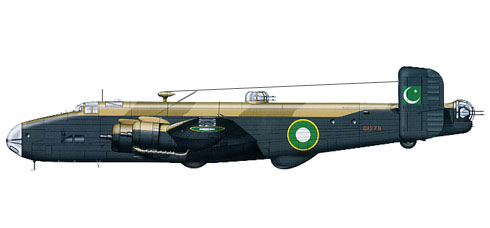
Handley Page Halifax B.VI, 12º Squadron, Pakistan Air Force, 1949.
In Service (1948-1954)
Handley Page Halifax was one of the British front-line, four
engine heavy bombers of the Royal Air Force (RAF) during the Second World War.
A contemporary of the famous Avro Lancaster, the Halifax remained in service
until the end of the war, performing a variety of duties in addition to
bombing. The Halifax was also operated by squadrons of the Royal Australian Air
Force, Royal Canadian Air Force, Royal New Zealand Air Force, Royal Pakistan
Air Force and Polish Air Force.
First two Halifax were delivered in 1948, used the aircraft
was used during 1948 Kashmir War for night-time supply drop missions at Skardu
and other northern areas of Pakistan. 6 ex-RAF Halifax B-VI were delivered in
1949, equipping No.12 Heavy Bomber Squadron raised in March 1950. Squadron
converted to a composite squadron of four flights, including one flight of
Halifax bombers, in September 1953.
Eventually all Halifax aircraft were transferred to
long-term storage in 1954 and then disposed of as salvage.
H.P.61 Halifax VI
When the improved and more powerful Hercules 100 became
available in 1944, the higher performance Mk.VI was introduced. With minimal
changes from the Mk.III, the Mk.VI retained the same HP model number. Which
featured Hercules 100 radials providing 1,250 kW (1,675 HP) take-off power,
plus engine intake filters and a pressurized fuel system — the changes being
mostly intended to support tropical operations in the Far East. They were
otherwise similar to the B.Mk III in airframe configuration and equipment fit.
Late production machines had a Boulton-Paul D.Mk II tail turret with twin
12.7-millimeter Browning machine guns.
A total of 643 B.Mk.VI machines were built.
During the war, many wondered why the Halifax remained in
production when the Lancaster seemed the better bomber, but with the
introduction of the B.Mk III, there wasn’t that much to distinguish the two in
terms of range, ceiling, and speed. The Halifax did have a somewhat smaller
bombload, about 85% that of the Lancaster, and the ultimate loss rate was
higher — about one Halifax per 21 sorties, versus about one Lancaster per 27
sorties. However, this statistic was skewed by high losses of Halifaxes in the
early days — the Halifax was in combat service about a year before the
Lancaster became a real force — and in maturity, the odds of surviving being
shot down in Halifax were almost twice as great as they were for a Lancaster.
While the ultimate full load of bombs carried by the Halifax during the war was
only about a third that carried by the Lancaster, it was still more than
dropped by all other RAF bombers combined.